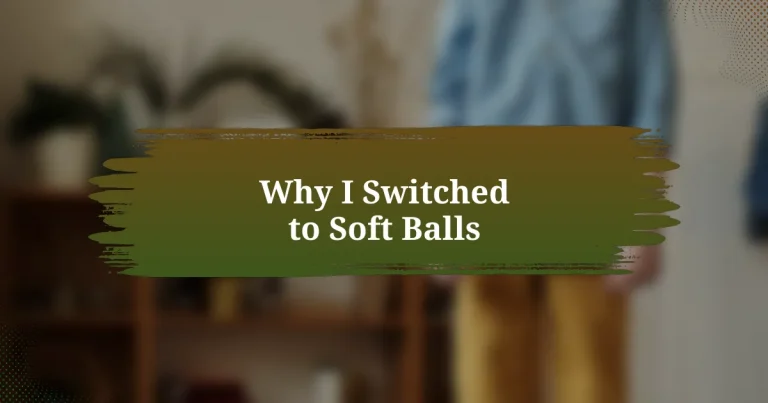Key takeaways:
- Practicing with soft balls enhances skills like hand-eye coordination, timing, and placement without the fear of injury.
- Soft balls promote dynamic gameplay, allowing players to focus on strategy, teamwork, and enjoying the game in a low-pressure environment.
- Choosing the right soft ball involves considering weight, size, and material to improve performance and prolong equipment life.
- Experimenting with different ball styles, such as color, can significantly enhance focus and overall enjoyment during practice.
How Soft Balls Improve Skills
Switching to soft balls during practice has significantly enhanced my skills and confidence on the field. I remember the first time I faced a fast bowler with a hard ball; the fear was palpable. With soft balls, I could focus on my technique without the worry of injury, which has been a game changer for building my batting skills.
When I started practicing with soft balls, I noticed my hand-eye coordination improved almost immediately. I could really concentrate on timing and placement, rather than just survival! Isn’t it fascinating how removing that element of fear can lead to real progress? Kids get to learn at a comfortable pace, allowing them to experiment with their strokes in a way that hard balls just don’t allow.
What struck me the most was how soft balls allow for more dynamic gameplay, especially in drills. I remember setting up a mini-match with my friends, where we could really focus on strategy and teamwork. It was all about having fun while developing important skills, like communication and adaptability, which are crucial in cricket. Isn’t that what every young player should experience?
Personal Experience with Soft Balls
Switching to soft balls has transformed my approach to practicing cricket. I vividly recall the day I joined a local team and faced some nervous moments while getting accustomed to their speed. With soft balls, those initial jitters faded as I engaged more freely, exploring shots without the fear of getting hurt.
One afternoon, I gathered my friends for an impromptu cricket session using soft balls. The laughs and cheers echoed as we tried out new techniques, and I distinctly remember the thrill I felt learning to drive with perfect timing. It felt liberating, almost like rediscovering the joy of the game. Have you ever felt that thrill in practicing something new? For me, that exhilaration solidified my love for cricket, and I believe it can do the same for other kids.
The camaraderie during those soft ball games created bonds that still last today. Those moments weren’t just about improving skills; they taught us to support each other and embrace learning in a fun, low-pressure environment. Isn’t it amazing how some simple adjustments can lead to such valuable life lessons on and off the field?
Tips for Choosing Soft Balls
When choosing the right soft ball, consider the weight and size that best suits the age and skill level of the player. I remember my first encounter with a light-weight soft ball; it felt like a feather in my hand, allowing me to build confidence in my throws and catches. What I found truly remarkable was how the right size made practicing easier and more enjoyable.
It’s crucial to check the ball’s material as well. For example, a durable foam ball held up well during our practice sessions, providing reassurance against wear and tear. Have you ever been frustrated with a ball that breaks too easily? I learned that investing in a quality soft ball enhances not just performance but also extends the life of your equipment, making it a wise decision in the long run.
Lastly, I recommend trying out different styles. We once experimented with brightly colored balls that were easier to track in the air, and the results were impressive! This little change made our games more exciting and helped improve our hand-eye coordination. Have you ever noticed how something as simple as color can influence your focus? Trust me, it makes a world of difference when you’re out there playing.



